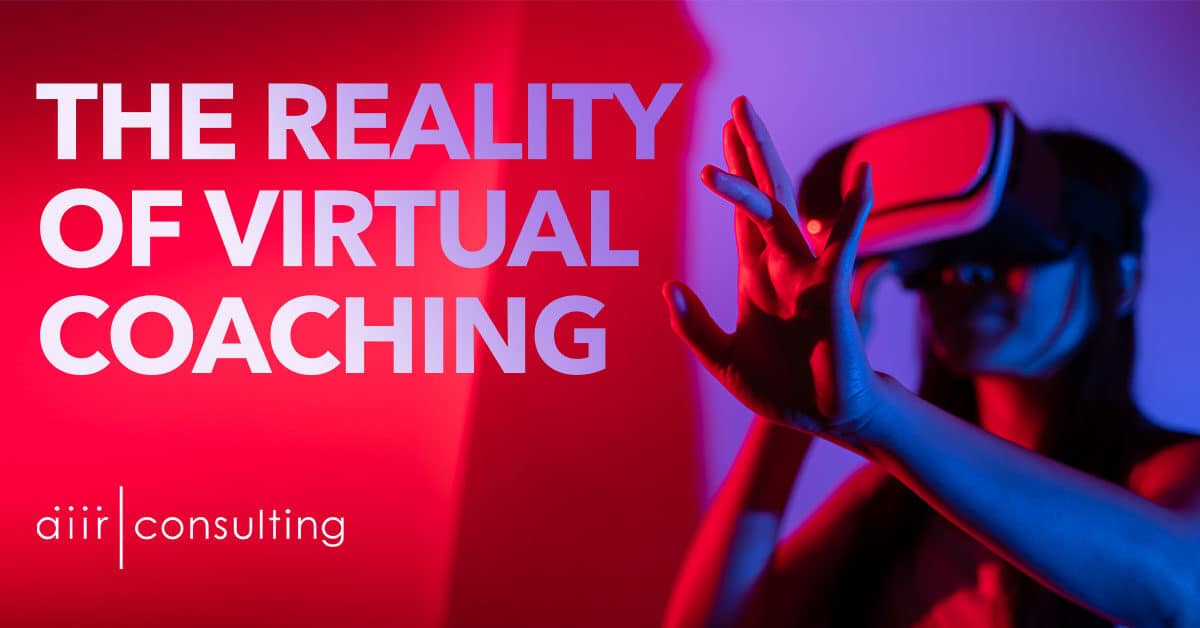What 10 Years of Delivering Virtual Coaching Reveals About How Covid-19 Will Change the Coaching Industry for the Better
The workforce is entering a global experiment with remote work. As the coronavirus continues to spread, even companies that have resisted remote work are restricting travel and asking their employees to stay home.
Some have predicted that the coronavirus outbreak will represent a tipping point, after which remote work will be the norm. 63% of employers already allow employees to work from home, and 70% of those employees work remotely at least once a week.
For coaching, the virus could represent a similar tipping point. For decades, the coaching industry has been built around in-person one-to-one and group engagements. Now, as huge portions of the working world log in and work from their kitchen tables, much of the coaching industry will be forced to adapt.
As a technology-forward firm, AIIR is ready to support our customers. Since our founding, we have leveraged innovative technology to provide high-impact coaching in a virtual environment, achieving excellent results. Here are some of the insights and tips we’ve gleaned from over 10 years of leading the way in virtual coaching.
Some Coaches are Moving Forward
Executive coaching has evolved considerably in recent years. A 2008 study found that only 26% coaching occurred virtually. Ten years later, only 35% of coaching was conducted in person. Once considered a luxury reserved for the executive suite, virtual coaching has made executive coaching accessible to leaders at all levels by solving three key issues:
Accessibility
48% of talent professionals identified lack of time as a key challenge to scaling coaching throughout their organization. In a virtual coaching engagement, clients can essentially access their coach on demand – anytime, anywhere.
Cost Savings
Another 27% identified lack of budget as a common challenge. By reducing or eliminating in-person sessions, telepresence significantly reduces the travel expenses associated with traditional executive coaching.
Geography
Virtual coaching eliminates traditional geographic constraints, enabling clients to choose their coach based on quality and fit, rather than geography.
But, Most of the Industry is Still Behind
But for all its evolution, much of the coaching industry is stuck in the technological dark ages. Even though video conferencing is integrated seamlessly into the technologies most of us interact with every day, the vast majority of executive coaching is delivered over the phone. Only 24% of coaches use video for coaching engagements.
On the one hand, coaching over the phone can be effective. A study found that, in coaching engagements conducted exclusively over the phone, the strength of the coach-coachee relationship could be as strong as in coaching engagements conducted in person.
On the other hand, video coaching offers a far superior experience.
Neurosynchrony
So much of communication is nonverbal. The absence of visual connection makes it impossible for coach and coachee to discern non-verbal cues over the phone. The simple act of establishing eye contact enables coach and coachee to achieve neurosynchrony and a more robust social connection. This is because direct eye contact produces oxytocin, a vital hormone associated with trust. This leads to a more complete and impactful coaching relationship.
Accountability
Leaders are bombarded by inputs, from Slack messages to meetings. Many spend more than half of their workday receiving and managing information, with 62% admitting that the quality of their work suffers because they can’t sort through the information they receive. This constant bombardment is a recipe for multitasking, even during coaching sessions. Video coaching ensures a high level of accountability and engagement.
Opportunities Beyond the Coaching Engagement
Even among coaches that favor video over the phone, most miss critical opportunities to leverage technology in a way that deepens the coaching experience. Executive coaching can produce incredible results. But those results are only sustained through continuous reinforcement.
The fractured system of email and phone calls most coaches currently use misses a chance to provide coachees an immersive experience — where the breakthroughs achieved in one-to-one sessions are reinforced through on-demand resources, encouragement, and continual communication with their coach.
Maintaining the Human Touch, Without Human Touch
While most of the industry is behind, there are also coaching providers who take reliance on technology too far. Some of the newest entrants into the industry use chatbots, AI, and pools of generic coaches to create an on-demand coaching experience. But this shiny delivery system often comes at the cost of human connection.
Rather than replacing the human connection between coach and client, AIIR believes in leveraging technology to deepen it. Combining world-class coaches, video conferencing with asynchronous communication, on-demand micro-learning, and real-time analytics are a necessary step into the future for an industry that has been perpetually stuck in the past. But it is still the strength of the coach-coachee bond that determines coaching’s ability to create long-term positive outcomes, and prevents the rare negative effects.
Although the coronavirus has thrust the coaching industry into the future, the move toward virtual coaching was already inevitable. The accessibility, cost savings, unlimited geographical reach and enhanced effectiveness of virtual coaching vs. both telephone and traditional coaching is too compelling for the industry to stand still.
Are You Ready To Shape A Better Future Together?
Partner with AIIR to empower your leaders and ascend into the future.
